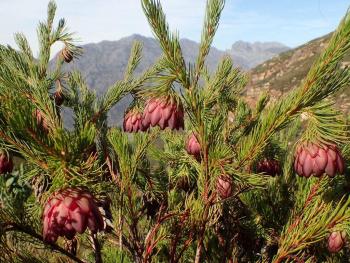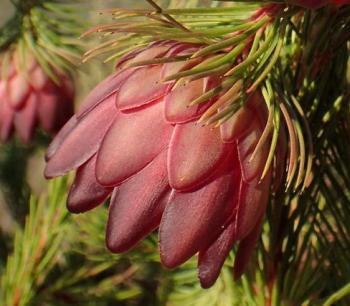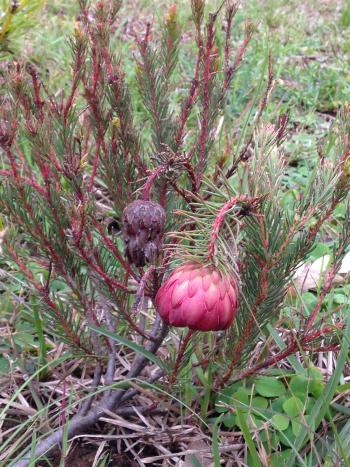Protea nana
Protea nana (P.J.Bergius) Thunb.
Family: Proteaceae
Common names: mountain rose, mountain-rose sugarbush (Eng.); bergroos, warebergroos, skaamblom, skaamroos, skaamrosie (Afr.)
Introduction
A delightful shrub, with soft needle-shaped leaves that shimmer in the wind, while its cup-shaped, crimson flower heads, shyly nod.

Description
Description
Protea nana is a charming, dainty, densely branched, small shrub, up to 1.3 m tall, with glabrous, deep green, needle-like, curved leaves, pointing upwards, about 18–30 mm long and 1.0–1.5 mm wide. The branches are gracefully curved carrying beautiful cup-shaped, wine red, pendulous flowers heads, from midwinter to early summer (from June to November). New branches are green and turn red in the following season and then turn brown when mature. The flower heads may vary in colour from red to bright red, dirty-faded red and pale green. The flowers have a distinct yeasty odour. The fruits ripen after about 7 months. This species is serotinous, which means that the seed will remain on the plant for years, until the plant is burnt in a fire or dies, and only then are released.

Conservation Status
Status
Protea nana was classified as Least Concern (LC) by the assessors of SANBI’s Red List of South African Plants in 2006. This assessment was reached because it grows fairly abundantly in protected areas on the mountains of the Western Cape.

Distribution and habitat
Distribution description
This species is found in varied mountain habitats often in numerous isolated stands between 400 and 900 m, from the Groot Winterhoek to Du Toitskloof, across to the Skurweberg near Ceres. It grows in moist, peaty to dry, sandstone soils, on mountain slopes.
Derivation of name and historical aspects
History
The genus Protea was named by the father of taxonomy, Carl Linnaeus, after Proteus, the mythological Greek god who could change his form at will. This name suitably recognizes the wide variety of forms that the protea family exhibits. The specific name nana, is derived from the Latin meaning, ‘dwarf’, due to the small delicate flower head. Linnaeus named this species, Protea rosacea, meaning 'rosy or rose-like', as it looks like a mountain rose, however Bergius named it nana some five years earlier.

Ecology
Ecology
Protea nana is a small, reseeding shrub, that is killed by fire, a known ecological system in the fynbos. This species is serotinous, which means it holds on to its seed until the plant is killed by fire or dies of old age. The seeds are small and light and covered with fine hairs (pappus), which aid wind distribution.
Its floral morphology, late winter flowering time and a distinct yeasty odour, indicate that it is adapted for rodent pollination. Its flower heads are visited by sunbirds and rodents including Otomys irroratus, Micaelamys namaquensis, Rhabdomys pumilio and Myomyscus (Praomys) verreauxi. In recent studies, each species displayed the presence of Protea nana pollen on their noses and in their scats. Myomyscus verreauxi is thought to be the most competent pollinator, as it displays superior climbing ability, in comparison to the other rodent species. Research has shown Rhabdomys pumilio to be highly destructive of P. nana flower heads, reducing them by up to 20%. Protea nana flowers have high nectar sugar content with presence of xylose. The sugar, xylose, can be metabolized by the Namaqua Rock Mouse, Micaelamys namaquensis via its gastrointestinal microflora (Johnson et al. 1999; Johnson et al. 2006) and is hence of benefit to this small-mammal species.
Protea nana has linear or needle-like leaves with reduced surface that function to prevent the loss of water during the hot summer season.
Proteas have proteoid roots, also known as cluster roots, that form clusters of closely spaced, short, lateral rootlets. They may form a 2- to 5 cm-thick mat just beneath the leaf litter. They enhance nutrient uptake, possibly by chemically modifying the soil environment to improve nutrient solubilization. As a result, plants with proteoid roots can grow in soil that is very low in nutrients, such as the phosphorus-deficient native soils of the Fynbos.
Uses
Use
The flower heads are best viewed from below, so ideally plant it on a slope, raised embankment or in a rockery where they can be seen. It grows well in heavier soils such as those derived from granite, but they must be well drained. These soils have better moisture retention than sandstone soils to help the plant survive during dry periods. It is a good container plant and cut flower.

Growing Protea nana
Grow
Protea nana can be propagated from seed or cuttings. Seed-grown plants tend to be more vigorous than those grown from cuttings. It is important to select fertile seed which are fat, whereas unfertile seed show no substance. Sow the seed in late summer to autumn, between March and May, in a well-drained, coarse, sandy soil, mixed with decomposed pine bark or a commercial fynbos soil mix. The growing media should be acidic with a pH between 5 and 6.7. The drop of night temperature in late summer to autumn is important to help stimulate the germination of fynbos seed. You may treat the seed by dusting with a systemic fungicide containing the active ingredient metalaxyl to prevent damping-off of seedlings. It is preferable rather to sterilize the soil with hot water as indiscriminate use of this fungicide has resulted in severe resistance problems. After sowing, sprinkle a light layer of sand to cover any exposed seed. Keep the soil moist, but do not overwater. Allow the soil to dry out a little between watering. Protect the seed from disturbance by covering with a wire grid. Seed should germinate from about 6 weeks on producing fleshy cotyledons, followed by true leaves. Pot out seedlings at the cotyledon stage or when the first true leaves appear. Seedlings should not be over potted, i.e. they should be potted into compartmentalized trays or small bags or pots. Young plants are placed under the protection of light shade 40%, to harden off and develop.
Protea nana can also be propagated from cuttings. They may be propagated from November to April selecting semi-hardwood heel cuttings. Select the disease-free cutting material, 200 to 250 mm long, taking upright-growing lateral shoots. Dip the cutting in a liquid rooting hormone for 5 seconds or apply a powder hormone to the cut surface. Place your cuttings in multi-trays in a well-drained and aerated medium of 70% perlite and 30% fine bark or coarse sand and finely milled pine bark. Cuttings are normally rooted on benches heated between 24º and 30ºC and regularly treat the cuttings with a fungicide to prevent fungal infection. Maintain hygiene by removing dead leaves and wilting cuttings. Rooting cutting of Protea nana is not as easy as pincushions and some other proteas and the cutting can take 3 months to root.
Protea nana grows in well-drained, nutrient-poor soils. Apply an organic seaweed-based fertilizer to encourage the sensitive proteoid roots to develop. Avoid using the chemical fertilizers containing high levels phosphorus, as proteas are sensitive to this. Phosphate toxicity can affect the young growth, causing scorching or necrosis and yellowing of the leaves.
Keep the soil cooler and moister during the hot dry season by mulching around the plants with pure decomposed compost or pine needles. Un-decomposed wood chips may carry detrimental root fungi such as Phytopthora or Armillaria which will kill the plants. Protea nana may be lightly pruned by removing the growth tips which will encourage branching and the development of more flowers.
Protea nana seems to be quite difficult to maintain in cultivation unless given specific conditions. It requires a garden position where it has well-drained, acidic soil, full sunlight and good aeration. It grows well in gardens where it is placed on a slope or in a rockery. It has a relatively short life span of approximately ten years which may be extended by good management, such as regular light pruning and feeding.
References
- Biccard, A. & Midgley, J.J. 2009. Rodent pollination in Protea nana. South African Journal of Botany 75(4): 720–725.
- Brown, N.A.C. & Duncan, G.D. 2006. Grow fynbos plants. Kirstenbosch Gardening Series. South African National Biodiversity Institute, Cape Town.
- Crous, W.P., Denman, S., Taylor, E.J., Swart, L., Bezuidenhout, M.C., Hoffman, L., Palm, E.M. & Groenewald, J.Z. 2013. Cultivation and diseases of Proteaceae: Leucadendron, Leucospermum and Protea. BIO CBS Biodiversity Series. The Netherlands.
- Duncan, G., Brown, N. & Nurrish, L. 2013. Grow proteas. Kirstenbosch Gardening Series. South African National Biodiversity Institute, Cape Town.
- Goldblatt, P. & Manning, J. 2000. Cape Plants. A conspectus of the Cape flora of South Africa. Strelitzia 9. National Botanical Institute, Pretoria & Missouri Botanical Garden, Missouri.
- Hutchinson, J., Phillips, E.P. & Stapf, O. 1912. Protea nana (P.J.Bergius) Thunb. Flora capensis, Vol 5, page 502.
- Johnson et al. 1999. Sugar preferences and xylose metabolism of a mammal pollinator, the Namaqua Rock Mouse (Aethomys namaquensis). Physiological and Biochemical Zoology 72, pp. 438–444.
- Johnson et al. 2006. Nectar xylose metabolism in a rodent pollinator (Aethomys namaquensis): defining the role of gastrointestinal microflora using C-14-labeled xylose. Physiological and Biochemical Zoology 79, pp. 159–168.
- Manning, J. & Goldblatt, P. 2012. Plants of the Greater Cape Floristic Region 1: the Core Cape Flora. Strelitzia 29. South African National Biodiversity Institute, Pretoria.
- Matthews, L. & Carter, Z. 1993. Proteas of the World. Bok Books International.
- Oliver, M. 2016. Observation of Protea nana, Limietberge. iNaturalist. Online. https://www.inaturalist.org/observations/11227942.
- Protea Atlas Project website: Afrikaans common names for proteas: http://www.proteaatlas.org.za/com_afr.htm accessed 3/2/17
- Rebelo, A.G. et al. 2006. Protea nana (P.J.Bergius) Thunb. National Assessment: Red List of South African plants version 2015.1. Accessed on 2017/03/02.
- Rebelo, T. 2000. Proteas of Cape Peninsula. Protea Atlas Project. National Botanical Institute, Cape Town.
- Rebelo, A.G. 2001. Proteas. A field guide to the proteas of southern Africa, edn 2. Fernwood Press, Vlaeberg, Cape Town.
- Rourke, J.P. 1982. The proteas of southern Africa. Centaur Publishers, Johannesburg.
- Rycroft, H.B. 1970. What protea is that? Purnell, Cape Town.
- Vogts, M. 1989. South Africa’s Proteaceae. Know them and grow them. Struik Publishers, Cape Town.
Credits
Mashudu Nndanduleni and Anthony Hitchcock
Kirstenbosch National Botanical Garden
March 2017
Acknowledgments: the authors thank Marian Oliver for allowing the use of her images of Protea nana growing in habitat.
Plant Attributes:
Plant Type: Shrub
SA Distribution: Western Cape
Soil type: Sandy, Loam
Flowering season: Spring, Early Summer, Winter
PH: Acid
Flower colour: Green, Red
Aspect: Full Sun
Gardening skill: Challenging
Special Features:
Horticultural zones







Rate this article
Article well written and informative
Rate this plant
Is this an interesting plant?
Login to add your Comment
Back to topNot registered yet? Click here to register.